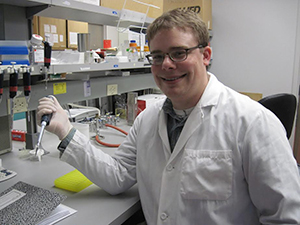By Crystal Simmons in The Potpourri – Magnolia Edition
Published April 21, 2014
In 1998, Luke Watson was a normal kindergartner who loved Aggie sports and watching ballgames with his dad. His younger sister Rachel loved animals, jewelry and art. She could talk at nine months old and got in her first fight at 3 after a bully threatened her brother.
Almost two decades later, Luke still loves sports and Rachel still loves animals.
However, everything else has changed. At 20, Rachel can’t walk, see or talk and suffers from seizures and dementia. Her brother Luke, 21, is also blind and his speech is starting to slur. Both have nearly exceeded their life expectancy.
Every day, they get a little worse, said their mother, Melinda Watson.
Both have Batten disease, which can mentally and physically incapacitate a normal child in a few years and leads to the deterioration of the nervous system. So far, there is no cure or treatment.
“The thing about Batten disease is, it’s a horrible disease. It’s slow. It takes away a piece of them all the time,” she said.
The disease strikes about one out of 100,000 people, qualifying it as an orphan disease that is often overlooked for research and funding. Children can develop Juvenile Batten disease around 6 and suffer progressive vision loss, intellectual and motor disability, speech difficulties, and seizures. Afflicted children usually only live to be in their 20s or early 30s.
Time is of the essence for these children, said Watson. But for Rachel and Luke, it may be too late.
From the day of their diagnosis in 1999, Watson has watched as her bright active children turned into mentally and physically handicapped adults. When she taught them something, she knew they could never progress.
“You cannot regrow the cells in the nervous system,” she said. “The best we can hope for is a treatment that can stop cell death or slow its progression.”
Now, hospital beds, shower chairs, wheel chairs, adaptive clothing and adult diapers are the tools that help her get through the day.
“I cannot take care of my daughter by myself. I have to pay someone to help me. She can stand, but that’s it. She’s too heavy for me to stand up by myself. Her care is total at this point,” she said.
According to the National Batten Disease Foundation, medical care for children afflicted with the disease can cost $3-4 million over their lifetime.
Luke and Rachel Batten Foundation
In many ways, Melinda Watson and her husband Sam have been pioneers in fighting to eradicate Batten disease.
Following her children’s diagnosis, Watson established the Luke and Rachel Foundation to fund Batten research.
A former special education teacher at Lowery Elementary in Cy-Fair ISD, Watson had no idea how to start a non-profit. Instead, she found she had a talent for public speaking that opened up new avenues for her.
In the non-profit’s infancy, it averaged $150,000 a year for research and medical care for children with the disease. But these days, Watson said the non-profit has been making less as she has had to transition into a full time nurse for her children.
Now advances in research are what keeps her going. For the past several years, Watson has been combining efforts with the Beyond Batten Foundation, a Texas based non-profit funding promising research for those in the beginning stages of the disease.
“When we came on the scene in 2008, they were still trying to determine what was causing that disease. We’re still trying to determine some of that. You can’t really find a cure until you understand what’s going on in the body,” said Mary Beth Kiser, president and CEO of Beyond Batten.
Since forming in 2008, the foundation has raised over 13 million through fundraisers and donations. It takes an average of $1.3 billion and 12 years to develop an effective treatment for most diseases, she said.
With foundation funding, Dr. Marco Sardiello has been able to move from Italy to Houston, where he is conducting research at the Jan and Dan Duncan Neurological Research Institute at Texas Children’s Hospital.
“One of the first grants we had brought them over to Texas Children’s Hospital in Houston,” said Kiser. “We had them set up lab their so they can do a lot more research and receive funding from the United States.”
Sardiello hopes to begin clinical trials on a treatment for a group of neurological diseases including Batten disease that result from the accumulation of toxic substances in the cell, which leads to cell death and disease symptoms.
The foundation has also funded a pre-conception genetic screening test that identifies carriers of Batten disease and 700 other rare diseases. It’s also being used as a diagnostic tool at Children’s Mercy Hospital in Kansas City.
The test is still not commercially available but is available upon request from the foundation.
“The problem with genetic diseases especially rare ones is that people don’t have any idea they have it. We all carry about four genetic defects and if you partner with someone with the same one you have a higher likelihood of having a child with that particular disease,” said Kiser.
Run to the Sun Relay
To raise funds for research, the foundation is holding its fourth annual Run to the Sun Relay April 26-27 in Austin.
More than 25 teams of runners from different cities and states will run more than 90 miles in an overnight journey through the Texas Hill Country.
The Watson’s will also be participating in the run with their group the LRBF Warriors. Each leg of the relay will be dedicated to a child suffering from Batten disease. A section of the relay will honor Luke and Rachel by featuring their photos and biographies.
Each year, the race raises a little over $700,000, but the foundation is striving to hit the million dollar mark this year.
For more information about juvenile Batten disease and Beyond Batten Disease Foundation, please visit www.beyondbatten.org.
To view the article, click here.


